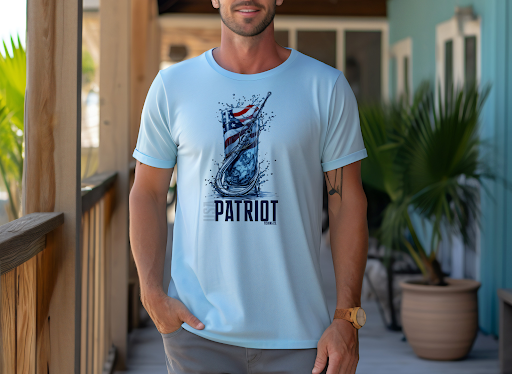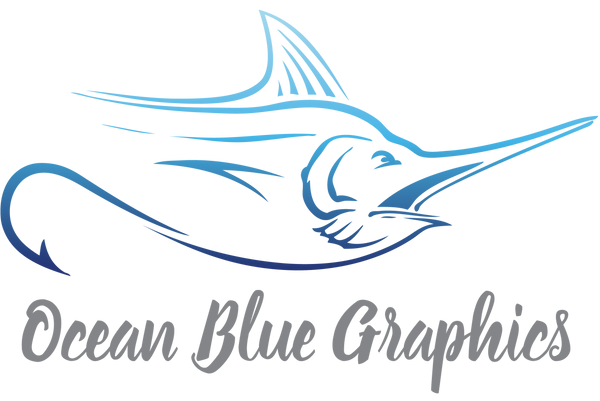
Custom Logo Screen Printing: Design Tips for High Impact Branding
Introduction: Why Custom Logo Screen Printing Still Matters
In a digital first world, your logo still needs to show up in the real one. From employee uniforms and promotional giveaways to retail merchandise and branded event gear, custom logo screen printing remains one of the most effective tools for building brand recognition and visibility. But not all logo prints are created equal.
For brand managers and marketing teams, the goal isn’t just to slap a logo on a t shirt it’s to make it pop, last, and communicate the brand’s essence. That requires a balance of smart design, production knowledge, and strategic planning.
At Ocean Blue Graphics, we specialize in helping businesses turn logos into wearable, walkable marketing. Below, we’re sharing expert backed tips on how to design your logo for high impact screen printing results.
1. Use Vector Logos for Clean, Scalable Results
The foundation of effective screen printing starts with your logo file. To ensure sharp lines and professional quality output, always work with a vector based logo (typically .AI, .EPS, or .SVG formats).
Why vectors matter:
- Scalability: Vector graphics can be resized without losing clarity, which means your logo looks crisp on a chest sized print or a full back design.
- Clean Lines: Screen printing requires precise linework. Raster files (like JPGs or PNGs) can appear blurry or pixelated when enlarged.
- Easier Color Separations: Vector files simplify the screen preparation process, ensuring each color is accurately separated and printed.
Tip: If your logo was created in Canva or saved as a flat image, consider having it professionally converted into vector format before sending it to your printer.
2. Think Strategically About Screen Mesh Size
Screen printing uses fine mesh screens to push ink onto fabric. But not all screens are the same. The mesh size determines the detail and thickness of the ink deposit and the right mesh size depends on your logo’s design and intended use.
Basic guidelines:
- Lower mesh counts (e.g., 110): Ideal for bold, heavy ink prints and athletic wear.
- Higher mesh counts (e.g., 230–305)Best for detailed logos and finer lines (especially for branding on softer or lightweight fabrics).
Discuss mesh size with your print shop if your logo includes:
- Thin outlines
- Small typography
- Intricate icons or emblems
By understanding how mesh size impacts your logo print, you can avoid blurriness, bleeding, or over inking that might distort your brand image.
3. Master the Art of Color Separation
If your logo uses multiple colors, each color requires a separate screen. This is known as color separation a critical step in the screen printing process.
Best practices:
- Limit your palette: Too many colors can drive up costs and complicate the process. Stick to 1–3 brand colors when possible.
- Use spot colors: Unlike CMYK or digital blends, screen printing uses solid spot colors for accuracy. Make sure your logo is prepared accordingly.
- Allow for underbase layers: On dark fabrics, a white underbase layer may be required to ensure colors appear vibrant.
Working closely with your printer can help ensure your logo colors print accurately and consistently across batches. Ocean Blue Graphics uses professional separation tools to preserve fidelity and vibrancy, especially for branded apparel runs.
4. Choose the Right Logo Placement for Maximum Impact
Placement is often overlooked, but it makes a huge difference in how your logo is perceived. The wrong placement can make a shirt feel awkward, while the right one reinforces brand authority and visibility.
Popular logo placements:
- Left chest: Classic and understated ideal for employee uniforms or polos.
- Full back: Offers bold visibility at events, festivals, or team outings.
- Sleeve prints: Great for secondary branding or website/social handles.
- Center front: Strong choice for statement pieces or promotional tees.
Placement Tips:
- Make sure your logo isn’t too small to be seen from a distance.
- Align placement with your brand voice subtle for professional settings, bold for lifestyle branding.
- Keep consistency across all branded apparel to strengthen brand recognition.
Ocean Blue Graphics provides mockups for multiple placement options so your team can review and visualize the impact before printing.
5. Choose Between Bold and Subtle Design Styles
Your logo should match the tone and personality of your brand. When it comes to screen printing, that tone is amplified by how bold or subtle the design appears on the garment. Get these amazing Patriot design t shirts now
Bold design styles:
- Large prints
- High contrast colors (e.g., white on black, red on white)
- Eye catching graphics
- Meant for maximum visibility and promotional appeal
Subtle design styles:
- Tone on tone prints (e.g., navy on royal blue)
- Minimalist icons or monograms
- Low contrast palettes
- Great for elevated branding or luxury appeal
Before you finalize your design style, ask: What do I want my logo to say about my brand in this context? For team events, bold may be better. For in office wear or client meetings, a refined look may make a stronger impression.
6. Consider Fabric and Garment Type
Even the best designed logo can fall flat if it’s printed on the wrong fabric. Screen printing ink reacts differently depending on the material, so it’s essential to choose garments that complement your design goals.
Top garment considerations:
- Cotton: Holds ink well and produces vibrant results. Best for most standard screen prints.
- Polyester or blends: Require special inks to avoid dye migration. Ideal for performance apparel.
- Fleece and hoodies: May distort fine designs use simpler logo versions and larger prints.
Ocean Blue Graphics can help you source premium garments that balance comfort, style, and screen print compatibility.
7. Stay On Brand: Design With Consistency
Whether you're printing apparel for employees, customers, or a branded event, consistency is key. Make sure your logo design matches your established brand guidelines in terms of:
- Font usage
- Logo proportions
- Color consistency (Pantone matched if possible)
- Clear space and margins
A consistent logo execution builds recognition and trust especially when your apparel is worn in public or shared online.
Pro tip: Build a brand asset kit that includes all approved logo versions, colors, and sizing guides. Share it with your screen printer to ensure accuracy and brand integrity.
8. Ask for Print Proofs Before Full Production
Before your design goes to press, always request a digital or physical print proof. This allows you to:
- Approve placement and sizing
- Confirm color matching
- Ensure readability of small details
- Avoid costly errors
At Ocean Blue Graphics, we provide professional mockups and test runs upon request so your final product aligns perfectly with your expectations.
Final Thoughts: Make Your Logo Work Harder
Custom screen printing is more than just a decoration it’s a branding opportunity. When your logo is printed well, it tells a story about your attention to detail, your professionalism, and the pride you take in your identity.
For brand managers and marketing teams, investing in a strategic screen printing process can result in long lasting apparel that builds awareness, loyalty, and credibility with every wear.
At Ocean Blue Graphics, we combine expert design consultation with high quality production to help you bring your branding vision to life. Whether you’re outfitting your team, launching a merch line, or preparing for an event, we’re here to make your logo look and last its best.
Frequently Asked Questions
We recommend vector formats like .AI, .EPS, or .SVG for sharp, scalable printing. If you only have a raster file, we can help convert it.
Yes, but each color requires its own screen. To keep costs down and prints clean, we recommend simplifying where possible.
Most orders are completed in 5 7 business days. Rush options are available for time sensitive projects.
We work with flexible minimums to accommodate small teams or bulk runs just contact us with your needs.
Absolutely! We offer design assistance, layout suggestions, and digital mockups so you can visualize your apparel before production.
